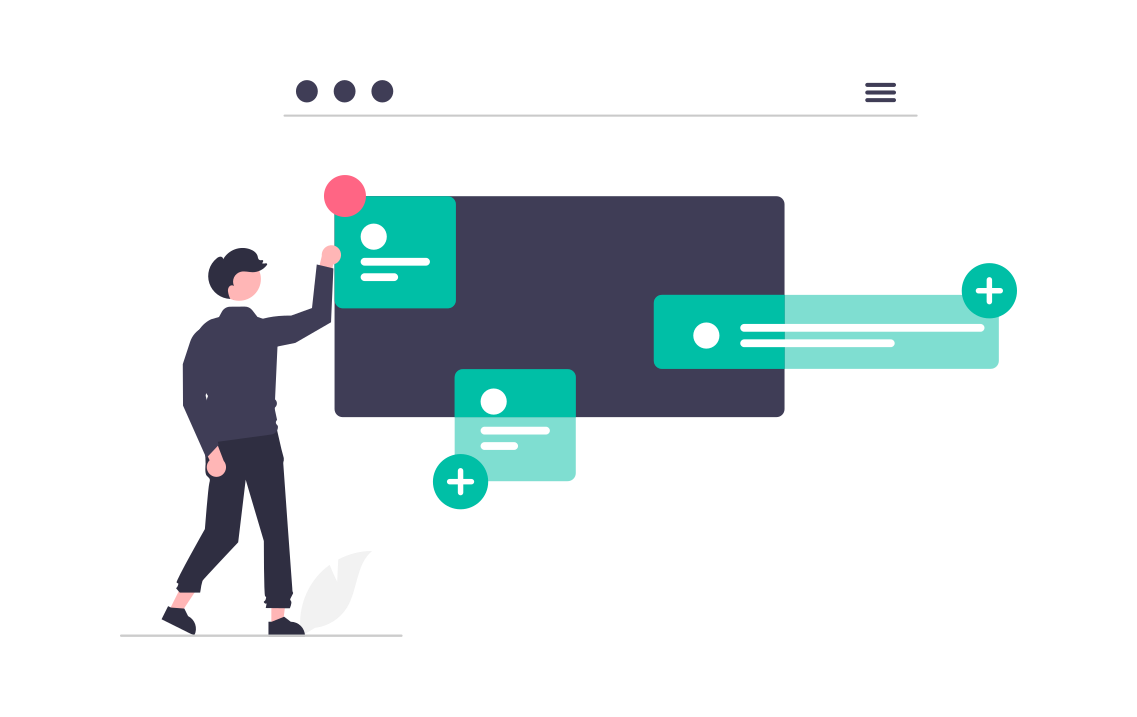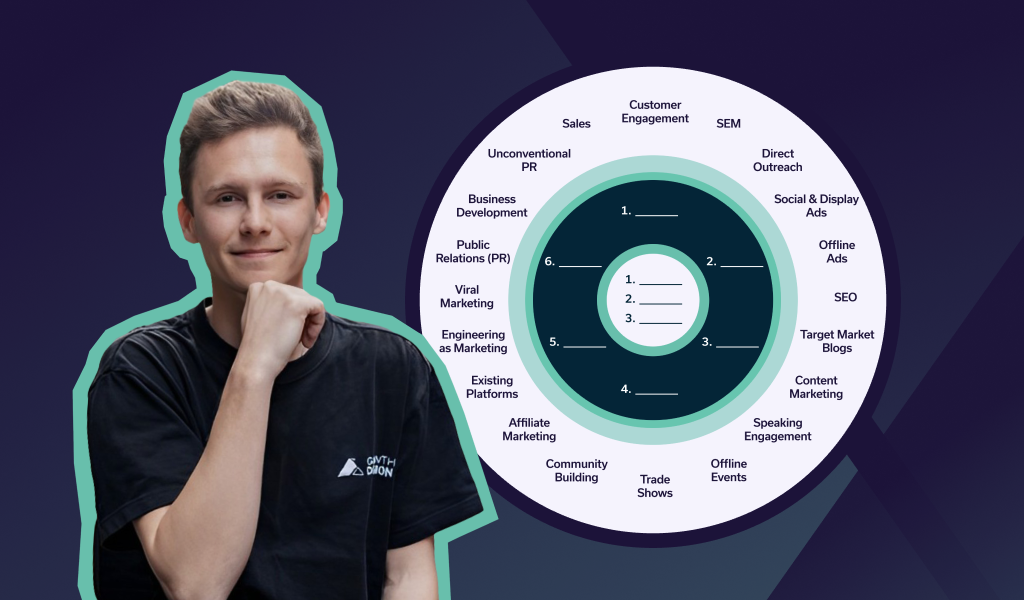What is the bullseye framework?
Originally developed by Gabriel Weinberg and Justin Mares but adopted and updated by us here at Growth Division, the bullseye framework is the answer to effective channel selection for start-ups and SMEs looking to accelerate growth with a smart marketing strategy.
The bullseye framework is a tactical component of a successful growth strategy and helps you make efficiency-focused and data-driven decisions about activating your focal traction channels. Poor distribution, not poor product is the more common reason for businesses struggling to take off after launch, highlighting why the bullseye framework is so popular for companies looking to grow.
In a 3-step process that looks at the outer, middle, and inner ring of a bullseye, you’ll find focus by selecting the most efficient routes to market from a starting 20 traction channels. The iterative exercise allows you to adapt your approach as your business priorities evolve and continue learning about what does and doesn’t work for your consumer.
What are the bullseye framework benefits?
The bullseye framework can help any business but is best geared up to support start-ups and SMEs who have a focus on growth and a consciousness of cost.
There are several benefits to using the bullseye framework as part of your marketing strategy. Here at Growth Division, we can help you navigate the process and experience all of the bullseye framework benefits.
Benefit 1: Easier Decision Making
Even the most experienced marketers can struggle to make objective decisions, especially at product or market launches when data is thinner than it will be in the future.
The bullseye framework starts with a process of hypotheses and, by conducting a series of growth experiments, ends with a proven and performance-based prioritisation of channels based on how they work together and towards your business goals.
This makes stakeholder management and decision-making much easier as there’s a logical and data-driven process in place to get you to the selection of your channel mix.
Example: The starting point of 20 traction channels includes everything from social ads to trade shows. Your media lead might be an advocate for one whilst your head of sales is pushing for the other. The reality is you might not have the budget for both. Systematically reviewing your options against your target audience’s needs and the creative ideas that come from your team will help you find the right place (and the right ring) for each channel.
Benefit 2: Sustained Growth
The bullseye framework isn’t a tactic only effective for launch or the first few months of a go-to-market strategy. The output of the bullseye framework offers a long-term and scalable approach to your channel mix.
By completing the exercise every 6 months, you can optimise and adapt your channel mix based on where your business is now and how each traction channel is performing.
You’ll track your Customer Acquisition Costs (CAC) for each channel and together as a whole, ensuring your business remains on the steady path to growth by knowing when to make changes and when to keep the current focus of the bullseye framework.
Tip: Ads often lead to immediate results, whereas more organic activities can take a while to establish and see their effectiveness. Set appropriate timeframes to analyse performance per channel and measure your growth objectives with this in mind.
Benefit 3: Better Spend
For many start-ups and SMEs, there’s often a surplus of ambition and a marketing spend that doesn’t quite match it. When in a growth phase, reducing wastage and spending in the most cost-effective way possible must remain a priority.
The bullseye framework is the ideal tactic for informing your business where to spend and where not to spend in its marketing strategy. By keeping your audience central and your budget top of mind throughout the approach, you can allocate your spend to the most effective channels that are going to help you see the best return on investment per growth phase.
Tip: Some channels cost more than others to run effectively. Consider the minimum viable budget you’d need to activate each channel from the start and factor that into your review of the framework. If you don’t give a channel the opportunity to succeed by backing it with enough spend, it’s the quickest way to both poor performance and wastage.
Benefit 4: Increased Efficiency
When it comes to driving efficiency, the bullseye framework doesn’t just help with costs. Resource, effort, and time are all areas you want to drive efficiency in when trying to grow your business.
For a marketing strategy to be successful, spending a healthy amount of time deep diving into the activation ideas per channel is a must. That’s a resource-heavy exercise, which is where the bullseye framework comes in to help.
Prioritising your traction channels in a structured way provides your business with the focus it needs about the level of effort to apply to each and where to apply it. By following the strategy, your resource allocation will become easier and you can maximise your chances of success in competitive markets.
Example: Many businesses activate on organic social when starting up as it’s an obvious free source of exposure. Whilst having a presence on social platforms can be beneficial, maintaining an active channel can take up a lot of resource from marketing, creative, and customer service teams. Obtaining significant organic reach and a following on social is not easy and you can quickly find yourself investing more time and effort into a regular posting cadence than the return is worth.
Benefit 5: More Holistic Approach
A successful channel mix strikes a balance of both the specific creative ideas for each traction channel, whilst also understanding the summary of all parts combined.
The bullseye framework collates individual channels into outer, middle, and inner rings. It encourages you to consider how each channel interacts and works together when contributing towards your business objectives.
By reviewing each option both in isolation and as part of an ecosystem, you’ll get a deeper understanding of your consumer journeys. As a result, you’ll better able to better assess the performance of your mix and the contribution of each component.
Benefit 6: Frequent Learnings
The bullseye framework approach acts as a powerful source of consistent learning and feedback. The idea is to regularly optimise what sits in your outer, middle, and central ring, through an established cadence of reporting and a constant understanding of what’s working and what’s not. With clear benchmarks and KPIs in mind, you’ll know when to keep pushing and when it’s time to update your approach.
Having the right focus on core metrics and analysing that data often will help you understand more about your product, your target audience, and the market. Think about the different tests and experiments you can integrate into your activity from the start to gain valuable insights. It’s often worth having a hypothesis first, and then using your performance data to validate or invalidate it.
Example: Activating target market blogs through guest posts can serve multiple purposes for a brand. It can build domain authority through backlinks, help build brand reputation as a thought leader, and can drive traffic directly to your site. If you decide to activate this channel, you’ll want to learn which metric you’re seeing the most value from and which type of blogs are most effective. Pose these questions and hypotheses first, then continually test them to drive powerful learnings and feedback loops from the start.
Talk to a Growth Advisor
We create a clear, focused marketing strategy by combining our expertise with your knowledge of your business.
Trusted by over 130 startups because our unique growth process and team of marketing experts unlock exponential growth











